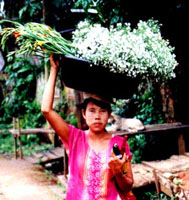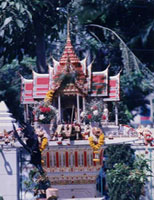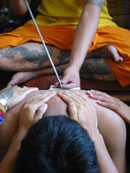Flowers and Plants
Thailand’s tropical climate provides the perfect growing grounds for lush plants and stunning flowers. The Thai love for flora helps keep Bangkok a surprisingly green city and plant and flower vendors can be found at most any corner. The Thai countryside is guaranteed to take your breath . Nevertheless, even when surrounded by a tropical paradise, most Thais prefer to add even more plants and flowers to the scenery.
Thai people seem to have an amazing artistic knack for floral arrangements. The green thumb is a common gift also but is unfortunately not contagious. I only need to buy a plant, bring it home and then look at it before it suspiciously starts wilting.
Flowers, plants and trees also play a large part in the practice of Buddhism. The ‘Bodhi’ tree is the most sacred of symbols in Thailand because the Lord Buddha was sitting under a ‘Bodhi’ tree when he obtained enlightenment. Buddhist pilgrims brought many more of these trees into Thailand from India and temples are commonly built around these trees. (‘Bodhi’ means enlightenment and a ‘Bodhi’ tree is in fact a fig tree.)
and temples are commonly built around these trees. (‘Bodhi’ means enlightenment and a ‘Bodhi’ tree is in fact a fig tree.)
The Lord Buddha spent most of his life in natural surroundings and Buddhist teachings emphasise coexisting with nature, not conquering it. Forest monasteries can still be found throughout Thailand and traditionally monks were forest dwellers. Monastery grounds in cities still reflect their rural heritage and provide a wonderful refuge.
Money is placed on branches of trees as a way to gather funds for monks. Money trees are typically displayed for several days and anyone can walk up and attach their donation. They can be found in Buddhist processions or even just sitting on the sidewalk outside of someone’s home or business.
Floral offerings are used in a wide variety of occasions in Thailand and secular and religious events call for different floral arrangements. Most importantly, flowers are brought to Buddhist temples or shrines for religious holidays or merit-making visits. Food or money may also be incorporated into the floral arrangement. Lotus buds are one of the more common offerings at Buddhist shrines and are presented with three joss sticks and one candle.
shrines for religious holidays or merit-making visits. Food or money may also be incorporated into the floral arrangement. Lotus buds are one of the more common offerings at Buddhist shrines and are presented with three joss sticks and one candle.
Most Thai Buddhists put fresh flowers on their home altars or spirit houses either daily or according to the lunar calendar. A friend of mine recently ran into a unique issue while trying to rent a house. The owner stated that either he had to promise to tend to the home’s altar daily or else she would come to the house every day to do so. The rent was a secondary matter.
A while back I noticed some school girls collecting a variety of petals and leaves in front of their house. I didn’t think much of it until later that evening when they showed me two ‘Bai-sri’ arrangements they had (effortlessly) made to give to their teacher. These arrangements typically incorporate folded banana leaves, flowers, and offerings of food and are typically presented to teachers and elders as a symbol of thanks and to newborn babies as a symbol of luck. ‘Kratong’ arrangements are used in the famous yearly ‘Loy Kratong’ festival, which happened to coincide with Halloween this year. These arrangements usually contain a candle, three incense sticks and a small coin set among flowers. People light the candles and incense, make a wish, and send their kratong gently out into the water. (See back issues 06 November 2000 http://www.bangkokpost.net/kat/archives/061100a.html) A ‘Jad paan’ floral arrangement is round and bowl shaped and used in wedding ceremonies to catch holy water that has been poured over the married couples hands. Large floral wreathes abound at funerals, and flowers are also presented as birthday presents or at the opening ceremony of a new business.
Garlands (‘Phuang malai’) abound in Thailand and are usually made of white jasmine buds with some marigolds, orchids or roses woven in to provide colour. They can often be seen hanging in taxicabs from the driver’s rearview mirror (to prevent accidents) and are often sold at busy traffic intersections by walking vendors.
The animistic nature of Thai Buddhism also leads to garlands being placed on ‘accident prone’ inanimate objects to appease the spirits inside. A red fire hydrant placed in the middle of a busy sidewalk in my neighbourhood has many pedestrians crash into it daily and therefore receives many garlands. So does a poorly placed electric pole that has caused several smashed bumpers and scratched doors.
Although I often have a difficult time keeping track of which floral arrangement is used for whom, where, and why, the visual and olfactory benefits of living in a country that is bursting with stunning floral arrangements and lush greenery is immense.
Keeping your eyes peeled for where people have placed garlands is an interesting thing to do while walking around. You might also be surprised at the number of flowers that go flying by attached to the backs of motorcycles. Visiting the flower market in Chinatown is another guaranteed eye-opener.
